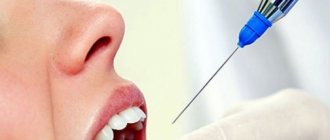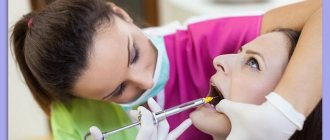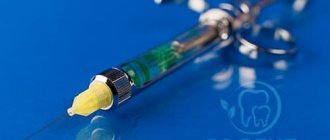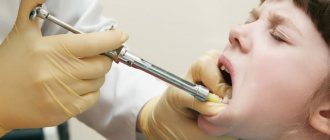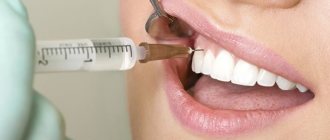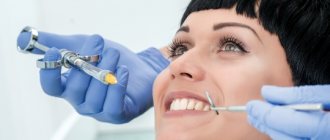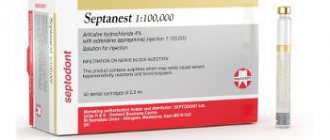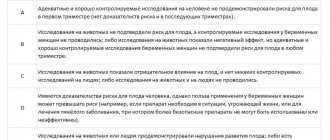Artikain
Articaine is a clear, colorless or yellowish solution for injection.
Indications for use: Infiltration and conduction anesthesia in dentistry. The drug is optimal when working with patients with a history of allergies, in gerontological and pediatric dentistry, and in patients with cardiovascular diseases. The onset of pain relief is from 1 to 3 minutes. Effective anesthesia time is at least 20 minutes. It is possible to prolong anesthesia by injecting the anesthetic.
Analogue of the drug: Ultracain D
Articaine is a local anesthetic (thiophene derivative) for infiltration and conduction anesthesia in dental practice, has a pronounced local anesthetic effect. In tissues (in a slightly alkaline environment) it undergoes hydrolysis and releases a base that has lipophilic properties and easily penetrates the membrane into the nerve fiber.
Articaine interacts with receptors, blocks sodium channels in the nerve fiber membrane, thus providing a local anesthetic effect. The effect of the drug begins quickly (the latent period is 1-3 minutes). Duration of action: 20 minutes. The rapid destruction of articaine to an inactive metabolite - articainic acid - is the reason for its very low toxicity, which allows repeated administration of the drug. In an acidic environment the effect is reduced.
Compound:
1 ml of solution contains: active substance: articaine hydrochloride - 40 mg; excipients: sodium chloride – 2.1 mg water for injection up to 1 ml.
Instructions for use
Before administering the drug, it is always recommended to perform an aspiration test in order to avoid intravascular administration of the drug. The pressure on the piston during drug administration should be adjusted depending on tissue sensitivity. Administration of the drug into inflamed areas of the mucous membrane is not recommended. Eating is allowed only after sensitivity has been restored.
For uncomplicated extraction of maxillary teeth in the non-inflammatory stage - 1.7 ml per tooth into the vestibular depot; if necessary, additionally - 1.0-1.7 ml.
For anesthesia for palatal incisions and suturing to create a palatal depot - 0.1 ml.
When removing premolars of the lower jaw (5-5) in an uncomplicated stage, infiltration anesthesia gives the effect of conduction anesthesia.
When preparing cavities and grinding teeth for crowns , with the exception of molars of the lower jaw, a vestibular injection of 0.5 - 1.7 ml per tooth.
When performing one treatment procedure, the maximum dose for adults is 4 mg/kg body weight.
Use during pregnancy and lactation: The safety of Articaine during pregnancy has not been established due to insufficient clinical data. Articaine penetrates the placental barrier. The question of using the drug by a dentist can only be accepted if the potential benefit from its use justifies the potential risk to the fetus. Has no effect on the fetus (except for possible bradycardia) with any technique of application and dose. During lactation there is no need to interrupt breastfeeding, since clinically significant concentrations of Articaine are not found in breast milk.
Contraindications: Hypersensitivity to articaine or other local anesthetic drugs of the amide group; megaloblastic B12 deficiency anemia; angle-closure glaucoma; diseases of the central nervous system; chronic hypoxia; bronchial asthma. Paroxysmal tachycardia; atrial fibrillation; severe cardiac conduction disturbances (for example, atrioventricular block II-III degree, severe bradycardia), acute heart failure, arterial hypotension. Volumetric maxillofacial operations, as well as with intervention durations exceeding 20 minutes. Children under 4 years of age (efficacy and safety have not been studied). With caution: Women in labor with preeclampsia, bleeding in the last trimester of pregnancy.
Articaine, detailed instructions for use
, Russia
Shelf life: 3 years
Articaine, solution for injection 40 mg/ml, ampoules 2 ml No. 10 price: 870.00 rub. (on order)
Articaine 40 mg/ml, cartridges 1.7 ml No. 50 price: RUB 1,820.00
When is an anesthetic used and who is it allowed for?
"Articaine" is used for infiltration (injection near the tooth) and conduction (blocking a large nerve trunk) anesthesia. Indications for use in dentistry are as follows:
- dental treatment (therapeutic dentistry): deep caries, medium caries - treated with anesthesia less often, mainly if there is increased sensitivity or a low pain threshold. Various pulpitis and periodontitis are also treated with local anesthesia,
- surgical dentistry: "Articaine" is used for tooth extraction - simple and complex, for gum plastic surgery, removal of hard deposits (stones) from under the gums, root resection, installation of implants, maxillofacial operations,
- prosthetics (orthopedic dentistry): preparing teeth for prosthetics - turning for veneers and crowns, removing the dental nerve, filling root canals, installing fasteners for removable dentures on teeth, gum retraction (if necessary, pain relief).
The drug can be used in dental treatment
Articaine with adrenaline (Articaine + epinephrine)
Articaine with adrenaline is a clear, colorless or yellowish solution for injection.
Indications for use: Infiltration and conduction anesthesia during dental operations - uncomplicated removal of one or more teeth, treatment of cavities and grinding of teeth before prosthetics in adults and children over 4 years old. The drug can be used in patients at risk, in childhood (children over 4 years old), and during lactation. Effective anesthesia time is at least 45 minutes.
Analogs: Ultracain DS, Ubistezin, Septanest with adrenaline.
Articaine with adrenaline is a combination drug that contains articaine (an amide-type local anesthetic) and epinephrine (a vasoconstrictor), which is added to the drug to prolong anesthesia.
Articaine is a local anesthetic used for infiltration and conduction anesthesia in dental practice. The amide structure of articaine is similar to that of other local anesthetics, but its molecule contains one additional ester group, which is quickly hydrolyzed by esterases in the human body. The rapid destruction of articaine to its inactive metabolite (articainic acid) is associated with its very low systemic toxicity, allowing repeated injections of the drug. Local anesthetics cause reversible loss of sensation by stopping or reducing the conduction of sensory nerve impulses near the injection site. They have a membrane-stabilizing effect by reducing the permeability of nerve cell membranes to sodium ions.
Articaine with adrenaline has a rapid (latent period from 1 to 3 minutes) and strong anesthetic effect and has good tissue tolerance. The duration of anesthesia is at least 45 minutes. Due to the very low content of epinephrine in the drug, the effect of the latter on the cardiovascular system is insignificant: there is almost no increase in blood pressure and an increase in heart rate.
Articaine with adrenaline composition:
1 ml of solution contains: active ingredients: articaine hydrochloride - 40 mg and epinephrine hydrotartrate - 0.009 mg (in terms of epinephrine - 0.005 mg, which corresponds to the content of epinephrine in the solution 1:200,000);
excipients: sodium disulfite - 0.50 mg, sodium chloride - 1.00 mg, water for injection up to 1 ml.
Articaine with adrenaline: method of administration and dosage
The drug is intended for use in the oral cavity and can only be injected into tissues where there is no inflammation. It is impossible to inject into inflamed tissues. The drug cannot be administered intravenously. For anesthesia for uncomplicated extraction of teeth in the upper jaw in the absence of inflammation, it is usually sufficient to create a depot of Articaine with adrenaline in the area of the transitional fold by introducing it into the submucosa from the vestibular side (1.7 ml of the drug per tooth). In rare cases, an additional injection of 1 ml to 1.7 ml may be required to achieve complete anesthesia. In most cases, this eliminates the need for a painful palatal injection. When removing several adjacent teeth, the number of injections can usually be limited.
For anesthesia for incisions and sutures in the palate to create a palatal depot, about 0.1 ml of the drug is required for each injection.
In the case of removal of mandibular premolars in the absence of inflammation, mandibular anesthesia can be dispensed with, since infiltration anesthesia provided by an injection of 1.7 ml per tooth is usually sufficient. If in this way it was not possible to achieve the desired effect, an additional injection of 1-1.7 ml of anesthetic should be performed into the submucosa in the area of the transitional fold of the mandible on the vestibular side. If in this case it was not possible to achieve complete anesthesia, it is necessary to conduct a conduction block of the mandibular nerve.
When treating cavities and grinding teeth for crowns , with the exception of the lower molars, depending on the volume and duration of treatment, the introduction of Articaine with adrenaline into the area of the transitional fold on the vestibular side in a dose of 0.5-1.7 ml per tooth is indicated.
When performing one treatment procedure, adults can be administered articaine in a dose of up to 7 mg per 1 kg of body weight. It was noted that patients tolerated doses up to 500 mg (corresponding to 12.5 ml of solution for injection) well.
For pediatric patients (over 4 years old), the dose of Articaine with adrenaline is selected depending on the age and body weight of the child, but it should not exceed 5 mg of articaine per 1 kg of body weight.
In elderly patients and all patients with severe renal and hepatic insufficiency, increased plasma concentrations of articaine may occur. For these patients, the minimum doses necessary to achieve a sufficient depth of anesthesia should be used.
To avoid accidental entry of the drug into the blood vessels, before its administration, a two-stage aspiration test should always be performed with the needle rotated 90 and 180 (see detailed instructions).
Severe systemic reactions due to unintentional intravascular administration of the drug can be prevented by slow administration: first inject 0.1-0.2 ml of the drug, then, after 20-30 s, slowly inject the rest of the drug. The injection pressure should correspond to the sensitivity of the tissue.
Contraindications: Hypersensitivity to articaine or to other amide-type local anesthetics, unless in case of hypersensitivity to amide-type local anesthetics, an allergy to articaine has been excluded by appropriate studies conducted in compliance with all necessary rules and requirements. Hypersensitivity to epinephrine; hypersensitivity to any of the auxiliary components of the drug. (see detailed instructions).
Articaine with adrenaline (Articaine + epinephrine), detailed instructions for use
Articaine with adrenaline (Articaine + epinephrine)
, Russia
Shelf life: 2.5 years for cartridges, 3 years for ampoules
Articaine with adrenaline, solution for injection (40 mg+0.005 mg)/ml, ampoules 2 ml No. 10 price: 870.00 rub. (on order)
Articaine with adrenaline 40+0.005 mg/ml cartridges (1:200,000) 1.7 ml No. 50 price: RUB 1,705.00
Use with caution - in pregnant women, children and patients at risk
“Articaine” without adrenaline is allowed in dentistry during pregnancy (since it does not reduce blood supply to the uterus), children over 4 years old, as well as patients over 65 years old, people with liver and kidney diseases. But in any of the above situations, the drug is used with caution. And if an anesthetic is used for the first time in life, the dentist first administers a “microdose” to rule out allergies.
The product should be used with caution during pregnancy
Good to know! During lactation (breastfeeding), you can use this anesthetic and continue to feed the baby as usual - without pumping and temporary transfer to artificial formula. Studies have shown that articaine is slightly excreted in breast milk and does not harm the baby.
The drug is intended for use in the oral cavity.
In order to avoid accidental release of the drug into the blood vessels, a two-stage aspiration test should always be performed before its administration, rotating the needle 90 and 180°. The main systemic reactions that may develop as a result of accidental intravascular administration of the drug can be avoided by following the injection technique: after an aspiration test, 0.1 - 0.2 ml of the drug is slowly injected, then, no earlier than 20 - 30 seconds later, slowly injected the remaining dose of the drug. The injection pressure should correspond to the sensitivity of the tissue.
To prevent infection (including with the hepatitis virus), it is necessary to ensure that new sterile syringes and needles are always used when taking the drug from ampoules. Opened cartridges must not be reused for other patients (risk of hepatitis infection)! Damaged cartridges must not be used.
The drug should not be used if it has changed color or becomes cloudy. Dosage regimen
For anesthesia during uncomplicated extraction of teeth of the upper jaw in the absence of inflammation, it is usually sufficient to create a depot of the drug Articaine with adrenaline forte in the area
transitional fold by introducing it into the submucosa from the vestibular side (1.7 ml of the drug per tooth). In some cases, it may be necessary to achieve complete anesthesia.
additional administration from 1 ml to 1.7 ml. In most cases, this eliminates the need for a painful palatal injection.
For anesthesia for incisions and sutures in the palate in order to create a palatal depot, about 0.1 ml of the drug per injection is required.
When removing several adjacent teeth, the number of injections can usually be limited.
In the case of removal of mandibular premolars in the absence of inflammation, as a rule, it is sufficient to administer 1.7 ml of the drug per tooth. If in this way it was not possible to achieve the desired
effect, an additional injection of 1 - 1.7 ml of anesthetic should be performed into the submucosa in the area of the transitional fold of the mandible on the vestibular side.
If in this case it was not possible to achieve complete anesthesia, it is necessary to conduct a conduction block of the mandibular nerve.
During surgical interventions, depending on their severity and duration, the drug Articaine with adrenaline forte is dosed individually.
When performing one treatment procedure, adults can be administered up to 7 mg of articaine per 1 kg of body weight. It was noted that patients tolerated doses up to 500 mg well (corresponding to 12.5 ml of the drug).
Elderly patients and patients with severe renal and hepatic impairment
In elderly patients and all patients with severe renal and hepatic insufficiency, increased plasma concentrations of articaine may occur. For these
Patients should be treated with the minimum dose necessary to achieve a sufficient depth of anesthesia.
Children
- For pediatric patients (over 4 years of age), the minimum doses necessary to achieve adequate anesthesia should be used. The dose of Articaine with adrenaline forte is selected depending on the age and body weight of the child, but it should not exceed 7 mg of articaine per 1 kg of body weight (0.175 ml/kg). The use of the drug in children under 1 year of age has not been studied. Side effect
- The incidence of side effects is presented in accordance with the classification recommended by the World Health Organization: very often (2 1/10); often (2 1/100, < 1/10); uncommon (2 1/1000, <1/100); rare (2 1/10000, <1/1000); very rare (<1/10000), including isolated reports; frequency unknown (cannot be determined from available data). Immune system disorders Not known
- Allergic or allergy-like reactions. They can be expressed in the form of swelling and (or) inflammation at the injection site, but can also occur regardless of the injection site and manifest themselves in the form of redness, itching, conjunctivitis, rhinitis, angioedema of the face with swelling of the upper and (or) lower lip, cheeks, swelling of the larynx with a feeling of a “lump in the throat” and difficulty swallowing, urticaria and difficulty breathing, which can lead to anaphylactic shock.
- From the central nervous system / Often
Paresthesia, hypoesthesia, headache (due to the presence of epinephrine in the drug).
Infrequently
Dizziness.
Frequency unknown
- dose-dependent reactions from the central nervous system (including at excessively high doses or after accidental intravascular injection): anxiety, nervousness, stupor, confusion up to loss of consciousness, coma, respiratory failure up to respiratory arrest, muscle tremors and twitching muscles up to generalized convulsions;
- if the correct technique for administering the drug is violated or due to anatomical features in the injection area, damage to the facial nerve is possible, which can lead to paralysis of the facial nerve and a decrease in taste sensations.
Visual disorders
Frequency unknown
Visual disturbances (blurred vision, mydriasis, blindness, double vision), usually reversible and occurring during or shortly after injection of a local anesthetic.
Articaine with adrenaline forte, solution for injection (40 mg+0.01 mg)/ml, ampoules 2 ml No. 10 price: 870.00 rub. (on order)
Articaine with adrenaline forte 40+0.01 mg/ml cartridges (1: 100,000) 1.7 ml No. 50 price: RUB 1,785.00
Also purchased with this product:
- Dental materials, instruments and equipment
- Articaine INIBSA
- Articaine, Articaine with adrenaline, Articaine with adrenaline forte
- Brilocaine - adrenaline forte
- Cathejell with Lidocaine
- Dental injection kit AERS (disposable carpule syringe+carpule+needle)
- Disposable carpule syringe
- Orabloc®, injection solution
- Primacaine adrenaline
- Septanest with Adrenaline
- Scandinibsa® 3% (Scandinibsa 3%)
- Ultracain DS, Ultracain DS forte
- Ubistezin forte
- Carpule syringe
- Carpule needles
- Lidocaine
What contraindications exist
Any anesthetic drug has contraindications - some have more, some have less. If you refer to the instructions for use in dentistry, then “Articaine” without adrenaline has the following contraindications:
- inflammation of the tissue at the site of the planned needle puncture,
- neoplasms,
- polio,
- meningitis,
- hemorrhage in the cranial cavity,
- cardiovascular pathologies in the acute stage or immediately after it,
- significantly reduced blood pressure,
- poor blood clotting,
- allergy to this anesthetic.
Before using the drug, you should find out about contraindications. Contraindications
for the use in dentistry of “Articaine with adrenaline” and “Articaine with adrenaline forte” are a severe form of hypertension, tachycardia, and a recent heart attack. During lactation or pregnancy, the dose of adrenaline should not be higher than 0.005 mg/ml, but it is better to use a local anesthetic without it.
What side effects may there be?
Side effects are present with any local anesthetic - both in dentistry and in any other field of medicine. The most common side effects of Articaine (occur in 1-2 out of 100 patients) look like this:
- sensation of “pins and needles”, burning, tingling in the area where the anesthetic was administered,
- decreased sensitivity to external stimuli,
- headache,
- nausea and vomiting.
After use, nausea and vomiting may appear.
Less common side effects of Articaine are dizziness, nervousness, respiratory distress, swelling and inflammation of the gums, itching, redness, convulsions, visual or hearing disturbances, slow heartbeat, decreased blood pressure, anaphylactic shock, etc. d. If the needle is inserted incorrectly, injury to the facial nerve, including paralysis, is possible.
“During pregnancy, I had my teeth treated with an injection of articaine, it wasn’t painful or scary. And then with him too, because he works well for me. Then the head is not “cast iron”. But my sister didn’t feel well during the treatment; her heart was pounding frequently and she felt feverish. But she already has some minor problems with her heart. Maybe because of this."
Anastasia, review from otzovik.com
Anesthetics similar in composition
A complete analogue of “Articaine” in dentistry is the drug “Ultracaine D”. Produced in Germany by a large pharmaceutical company (Sanofi-Aventis, France). It has fewer contraindications than the domestic product and is better tolerated by patients. If we consider analogs that contain adrenaline, then we can use o (France) and “Ubistezin” (Palestine).
The product is completely free of stabilizing preservatives
special instructions
Do not administer IV! To avoid intravascular injection, an aspiration test must be performed. The injection pressure must correspond to the sensitivity of the tissue. You cannot inject into the inflamed area. Eating is possible only after sensitivity has been restored. Impact on the ability to drive vehicles and machinery
The possibility of allowing the patient to drive vehicles or engage in activities requiring high mental and motor reactions is determined by the doctor.
pharmachologic effect
The combined drug has a local anesthetic effect.
Artikain
- local anesthetic of the amide type of a number of thiaphenes. The mechanism of action is due to the stabilization of neuronal membranes and the prevention of the occurrence and conduction of a nerve impulse.
Epinephrine
- adrenergic agonist. Causes vasoconstriction at the injection site, which complicates the absorption of articaine and prolongs the effect of the local anesthetic effect. The onset of the effect is 0.5-3 minutes, the duration of action is 45 minutes.
